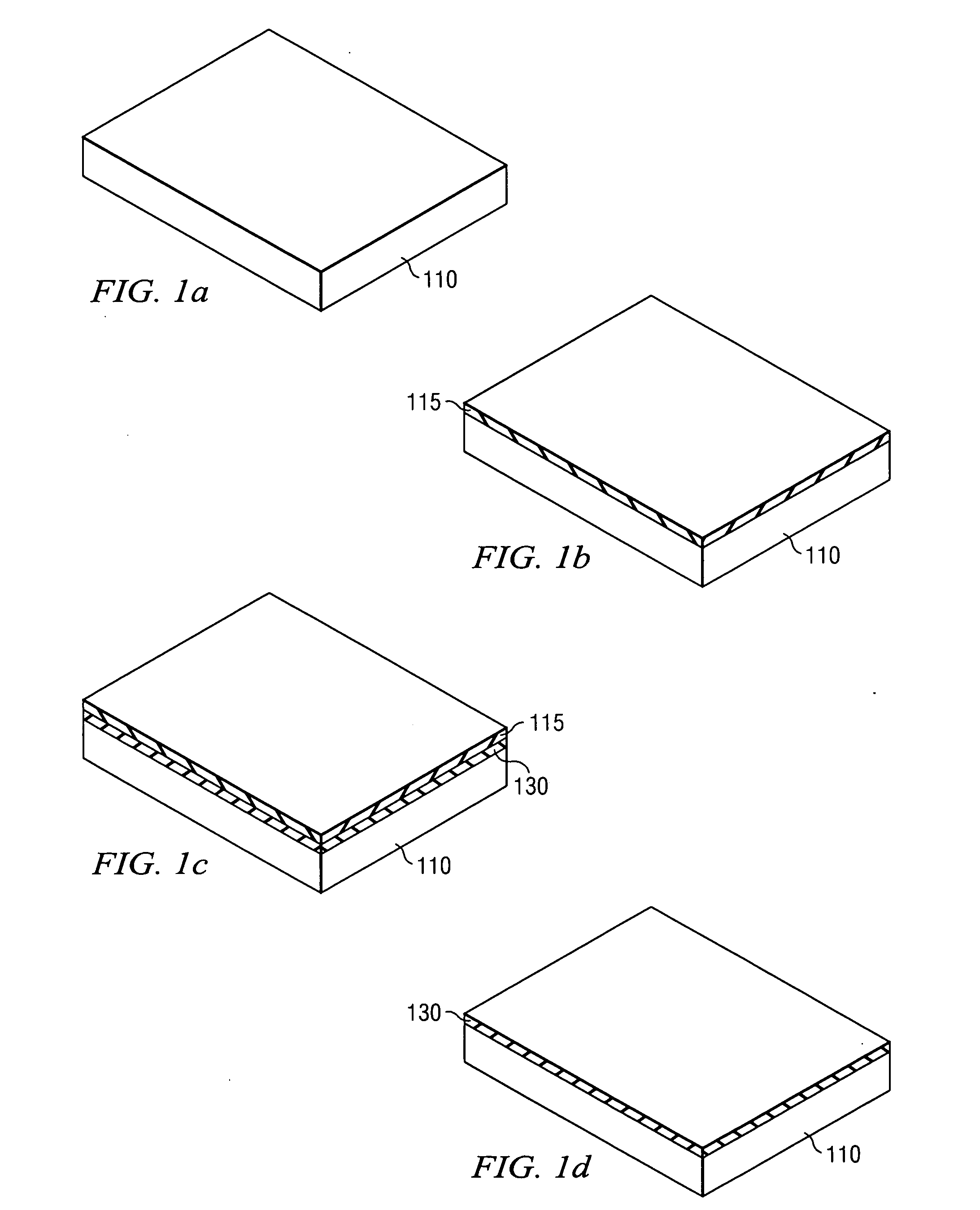Vertically aligned nanostructure scanning probe microscope tips
a scanning probe and nanostructure technology, applied in the field of nanotechnology, can solve the problems of limiting the usefulness and/or the ability to be produced in a large-scale process, the tip is very brittle and degrades easily, and the fabrication process is also serial in natur
- Summary
- Abstract
- Description
- Claims
- Application Information
AI Technical Summary
Problems solved by technology
Method used
Image
Examples
example 1
[0044] This example is a Si based process for producing high aspect ratio VACNF SPM tips on Si cantilevers using KOH for a through-wafer etch. Whole 4″ intrinsic Si double side polished wafers 110 are used as the substrate as shown in FIG. 1A. A highly doped p-type (p+) region 130 several microns deep is formed on the surface of the wafers. The depth of this layer will determine the thickness of the final cantilever structure and, ultimately, the resonant frequency of the cantilever. This doping can be accomplished using a variety of techniques. In this example, a spin-on dopant (SOD) technique based on a spin-on borosilicate glass (BSG) is depicted. After curing the SOD layer 115 at 170° C. for 1 minute (the result of this sub-process is shown in FIG. 1B), the wafers are placed in an annealing furnace operated at 1100° C. The amount of time determines the depth of the doped region 130. For a 5 μm deep p+ region, an annealing time of 5-6 hours is required (the result of this sub-pr...
example 2
[0045] This example is a Si based process for producing high aspect ratio VACNF SPM tips on Si cantilevers for electrochemical applications using KOH for the through-wafer etch. Whole 4″ intrinsic Si double side polished wafers are used as the substrate 210 as shown in FIG. 2A. A highly doped p-type (p+) region several microns deep is formed on the surface of the wafers using a spin-on dopant 215 (SOD). After curing the SOD layer 215 at 170° C. for 1 minute (the result of this sub-process is shown in FIG. 2B), the wafers are placed in an annealing furnace operated at 1100° C. The amount of time determines the depth of the doped region 230. For a 5 μm deep p+ region 230, an annealing time of 5-6 hours is required (the result of this sub-process is shown in FIG. 2C). The SOD layer is removed from the wafers using a solution of diluted HF (the result of this sub-process is shown in FIG. 2D). This process is followed by the deposition of a 200 nm thick layer of Si3N4 235 onto both side...
example 3
[0046] This example is a Si based process for producing high aspect ratio VACNF SPM tips on silicon nitride cantilevers using KOH for the through-wafer etch. Whole 4″ intrinsic Si double side polished wafers 310 are used as the substrate as shown in FIG. 3A. The wafers are placed in an LPCVD system and a layer 320 of low stress silicon nitride is deposited. This layer will form the cantilever body thus its thickness is determined by the desired resonant frequency of the cantilever structure (the result of this sub-process is shown in FIG. 3B). A 100 nm thick layer 325 of W is deposited onto the wafers. This layer 325 serves several purposes. It can be used to provide an electrical connection to the VACNF base on the completed cantilever structure. Primarily, its purpose is to prevent the surface of the wafer from charging during the direct current PECVD growth of the VACNF. If an AC discharge is used to perform the growth and no electrical contact is required to the VACNF base this...
PUM
 Login to View More
Login to View More Abstract
Description
Claims
Application Information
 Login to View More
Login to View More - R&D
- Intellectual Property
- Life Sciences
- Materials
- Tech Scout
- Unparalleled Data Quality
- Higher Quality Content
- 60% Fewer Hallucinations
Browse by: Latest US Patents, China's latest patents, Technical Efficacy Thesaurus, Application Domain, Technology Topic, Popular Technical Reports.
© 2025 PatSnap. All rights reserved.Legal|Privacy policy|Modern Slavery Act Transparency Statement|Sitemap|About US| Contact US: help@patsnap.com



